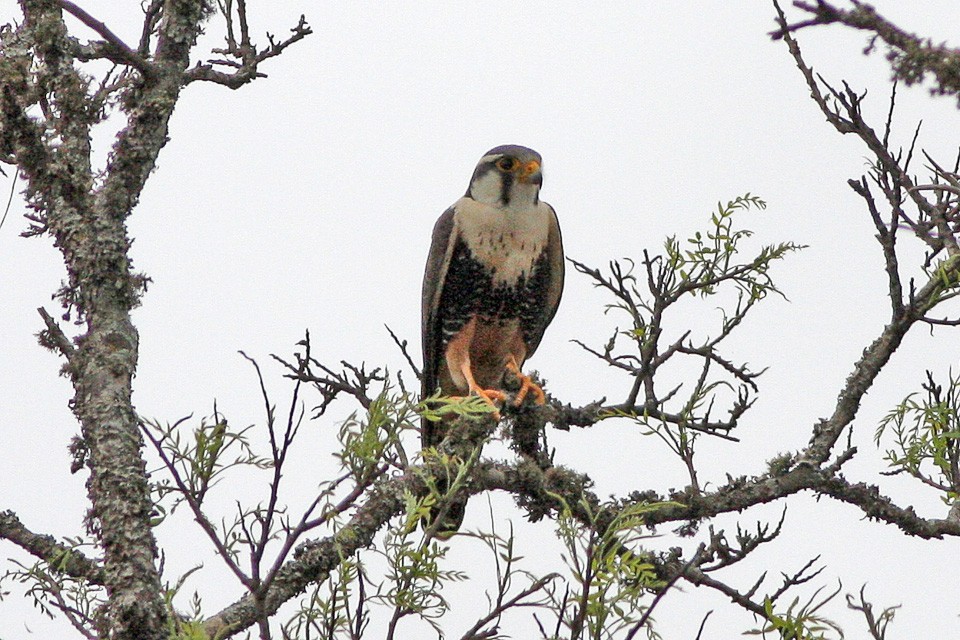Aplomado Falcon
A species of True Falcons Scientific name : Falco femoralis Genus : True Falcons
Aplomado Falcon, A species of True Falcons
Botanical name: Falco femoralis
Genus: True Falcons
Content
Description People often ask General Info
Description
The aplomado falcon is very slender, long-winged, and long-tailed, the size of a small peregrine falcon (F. peregrinus), at 12–16 in (30–40 cm) long and with an average wingspan of about 36 in (90 cm), but only half the weight, at about 7.3–10.8 oz (208–305 g) in males and 9.6–16 oz (271–460 g) in females. In adult birds, the upperparts are dark blue-grey, as is much of the head, with the usual falcon "moustache" contrasting sharply with the white throat and eyestripe. The upper breast continues the white of the throat; there are black patches on each side of the lower breast that meet in the middle; the belly and thighs, below the black patches, are light cinnamon. The tail is black with narrow white or grey bars and a white tip. The cere, eye-ring, and feet are yellow or yellow-orange. Except that females are bigger than males, the sexes are similar. Juvenile birds are very similar to adults, but their upperparts and belly band are blackish brown, the chest is streaked with black, the white on the head and breast is buffy, and the cinnamon on the underparts is paler, as are the feet. This species may be confused with the bat falcon (F. rufigularis) and the orange-breasted falcon (F. deiroleucus), which have similar white-black-rust patterns below, but those species are built more like peregrine falcons and have solidly blackish heads and darker rufous bellies. These two species are generally considered to belong to the same lineage as the aplomado falcon. Two other Falco species of the Americas, merlin (F. columbarius) and American kestrel (F. sparverius), seem to be closer to the Aplomado group than most other falcons, but the relationships of all these lineages are fairly enigmatic. All that can be said with some certainty is that they diverged as part of an apparently largely western Holarctic radiation in the Late Miocene, probably around 8 to 5 million years ago. 
Size
38-46 cm (15-18 in)
Colors
Brown
Black
Gray
White
Orange
Life Expectancy
12 years
Nest Placement
Tree
Clutch Size
2 - 4 eggs
Incubation Period
1 brood
Number of Broods
31 - 32 days
Nestling Period
28 - 35 days
Feeding Habits
Aplomado Falcon's diet consists predominantly of small birds, large invertebrates, lizards, and mammals. They employ agile aerial pursuits and terrestrial chases, capturing insects and birds in flight. Notably, aplomado Falcon exhibit cooperative hunting within pairs, flushing and intercepting prey together.
Habitat
Aplomado Falcon inhabits a variety of open and semi-open landscapes, including dry grasslands, savannahs, and marshes. This bird of prey is adaptable to urban environments in regions like São Paulo, Brazil, and favors desert and coastal grasslands interspersed with yuccas and mesquites in the United States. Its range extends to Mexican coastal savannas, woodland fringes adjoining grasslands, and pastures with palm trees. Aplomado Falcon occupies territories from sea level up to altitudes over 13,000 feet in Andean grasslands, exhibiting a preference for warm, temperate to tropical climates with sparse vegetation.
Nest Behavior
The aplomado Falcon does not construct its own nest; it repurposes abandoned ones for laying eggs. Parenting involves both mates with seasonal timing for egg-laying and chick rearing.
Nest Characteristics
Aplomado Falcon typically utilize existing nests of other species such as raptors or corvids. Nesting platforms include trees, yuccas, power poles, or even ground locations in open grasslands and woodlands.
Dite type
Avivorous
People often ask
General Info
Feeding Habits
Bird food type
Sounds
Call
Recording location: Peru
Behavior
Aplomado Falcon exhibit remarkable speed and agility in flight, often outmaneuvering doves with ease. They are unique in their ability to run swiftly on terra firma while pursuing prey. Habitually roosting on the inner branches of trees, these falcons showcase close pair bonds, maintaining visibility to each other and engaging in intricate courtship displays, soaring or engaging in high-speed aerial pursuits. Cohesively, they demonstrate remarkable teamwork during hunts, with one partner flushing out prey for the other to capture.
Species Status
Not globally threatened.
Scientific Classification
Phylum
Chordates Class
Birds Order
Diurnal Birds of Prey Family
Falcons and caracaras Genus
True Falcons Species
Aplomado Falcon 